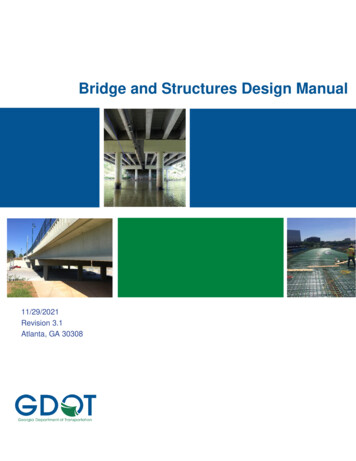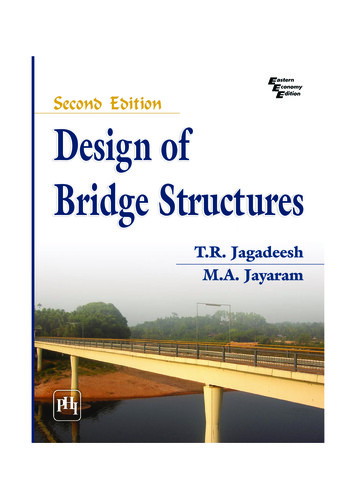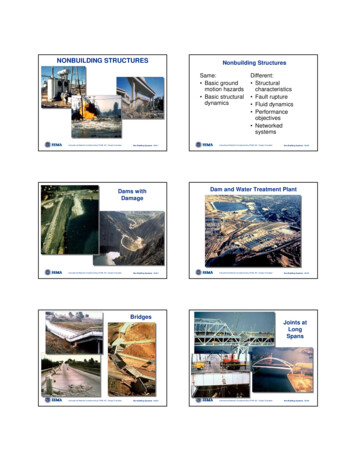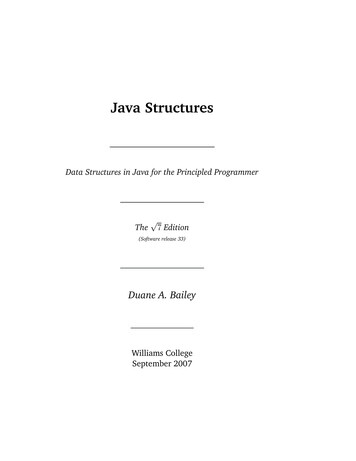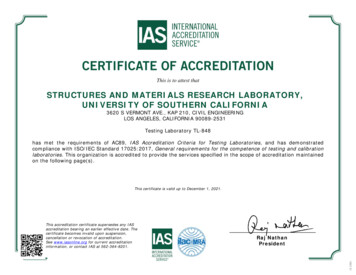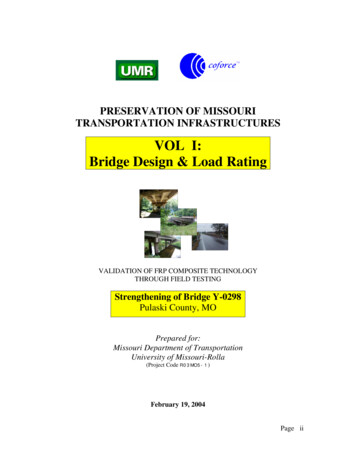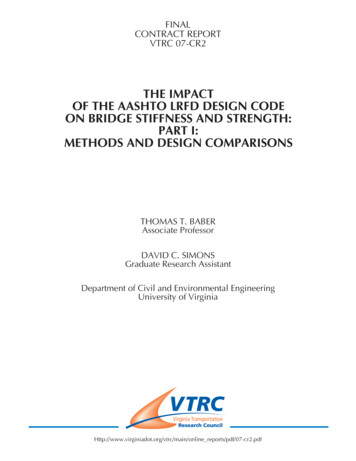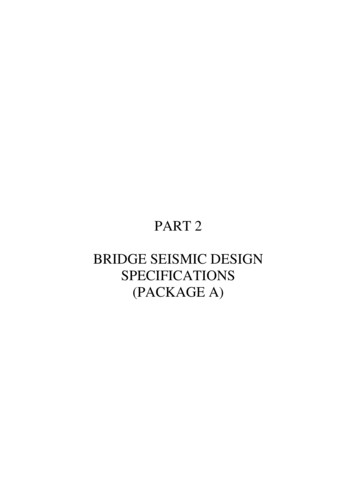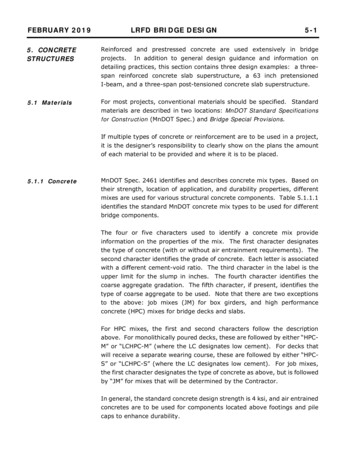
Transcription
Unit 5April 6, 2010
Why mightMaterials and Structuresbe important to hMechanicalFluidElectricalMaterial
Unit 5 will answer thefollowing questions:1. What material properties do we use to characterizematerials?2. How are those properties determined?3. What are the parameters that affect materials intension and compression?4. What are the optimal sizes of tension andcompression members to satisfy designrequirements?5. What forces do effective structures overcome?6. What is a truss and what structural problems do theysolve?7. What sort of calculation goes into bridge design?
Let’s look at yourFinalEngineering Practicum Project:
Design and Constructionof aSpaghetti Bridge
Why a Bridge Project?1) To take math and science out of the textbook and intoa project involving design, planning, and construction.2) Because the process is instructive and fun, and itexemplifies the difficulties of putting theory intopractice.You can build a bridge (or anything, for that matter)without math and science.But – to carry a maximum load, you need to understandmaterial properties, the theory of beams, and the physicsof canceling forces (statics).
Why Spaghetti?Why not toothpicks or Balsa Wood?1) Cost2) Spaghetti is very unforgiving.3) Available in a nice form for construction.Project Goal:Build a bridge out of spaghetti and epoxy that carries themost load suspended from the middle of the span.
Design Criteria/Constraints:Material Constraints:1) Regular-diameter spaghetti (2mm).2) 5-minute epoxy.Physical Constraints:1) Minimum length 50cm2) 25cm maximum height3) 250g maximum weight4) Only horizontal supports on ends5) Minimum decking width 5cm; maximum spacebetween decking members, 2mmGrading Criteria:1) Minimum passing load is 7kg (15.4lb)2) Highest class load determines grading scale(maximum load 100%)
Criteria Schematic: 5cm 2mm5cm x 10cmLoading PlatformBridge Decking 25 cm 2.5cmLoad50 cmTotal Weight 250gms
Materials and their PropertiesWe’ll begin by answering the question, “Why Epoxy?”Why not white (Elmer’s) glue?1. It’s water-based – what problem does this pose forspaghetti?Spaghetti is softened by the glue.2. Glue joints take forever to dry.3. Once dry, joints are not very strong.Why not model (airplane) glue?Dries quickly, but joints are slightly flexible.We want rigid joints.Why not hot glue?Joints are far too flexible
Materials and their Properties“Why Epoxy?”Why Epoxy?1. It’s not water-based2. Creates rigid joints3. Can choose the drying time (5-, 10-, 30-minute Epoxy)What is Epoxy?A polymer formed by the chemical reaction of a “resin”and a “hardener” – two viscous liquidsProblems with Epoxy:1. Irreversible curing2. Very messy3. Must mix two equal portions4. Possible endocrine disrupter and main cause ofoccupational asthma
Materials and their PropertiesAtomsThe story begins with atoms Various combinations of the 115 or so elements makeup all matter on Earth.How?Bonding:1. Covalent2. Ionic3. Metallic4. Hydrogen5. Van der Waals forces
Materials and their PropertiesStructureRelated to the arrangement of components1. Any length scale – nanometer, micrometer, meter, etc.2.DiamondC60 - FullereneGraphiteCarbon nanotubes
Materials and their PropertiesStructureRelated to the arrangement of components1. Any length scale – nanometer, micrometer, meter, etc.2.
Materials and their PropertiesPropertiesWhat is a Material Property?1. A quantitative trait – tells us something about amaterial, numerically2. They have units3. May be constant4. May be a function of independent variables (liketemperature)
Materials and their PropertiesProperties
Materials and their PropertiesPropertiesWhat is a Material Property?1. A quantitative trait – tells us something about amaterial2. They have units3. May be constant4. May be a function of independent variables (liketemperature)Different types of lMagneticAtomicMechanical Properties relate deformation to applied load
Materials and their PropertiesMechanical PropertiesYoung’s ModulusTensile StrengthCompressive StrengthYield StrengthShear StrengthDuctilityPoisson’s RatioSpecific WeightSpecific Modulus
Materials and their PropertiesMechanical Properties – Stress-Strain CurveYoung’sModulusTypical yield behavior for non-ferrous alloys.1: True elastic limit2: Proportionality limit3: Elastic limit4: Yield strength
Materials and their PropertiesMechanical Properties – Stress-Strain Curve
Materials and their PropertiesMechanical Properties – Stress-Strain Curve
Beams and loads--tension:Beam under tensionFailure occurs when ultimate tensile strength is exceeded.Maximum load is tensile strength times cross-sectional area.Lmax T * AcsFor regular spaghetti (diameter 2mm), maximum loadis 10 pounds.Load capacity does not depend on length.
Beams and loads--compression:dLBeam in compressionFailure occurs two ways:1) When L/d 10, failure is by crushing2) When L/d 10, failure is by bucklingWe are almost always concerned with failure by buckling.
Beams and loads--compressive buckling:Buckling strength F k * d4/L2To determine constant of proportionality k:1) Measure length and diameter of a piece of spaghetti2) Hold spaghetti vertically on postal scale3) Press down on spaghetti until it begins to bend4) Read load F on postal scale5) Calculate k
Some consequences of buckling properties:If a beam of length L and diameter d can support acompressive load of F,dFLthen a beam of length L/2 and diameter d cansupport a compressive load of 4F.d4FL/2
ALSO If a beam of length L and diameter d can support acompressive load of F,dFLthen a beam of length L and diameter 2d cansupport a compressive load of 16F.2d16FL
Bigger beams can be fabricated out of smaller beams,as in a truss.The fabricated beam will have the same buckling strengthas a solid beam, provided the buckling/tension strengthsof the component beams are not exceeded.
Beams and loads--bending:Very little strength. Never design a structure thatrelies on bending strength to support a load.
Beams and loads--bending:
Statics – the two conditions for static equilibrium are F0,1) At each joint or node:FxM00,Fy0,Fz02) Triangles cancel out moments3) Joints are assumed to carry no bending loads; thereforeall forces are compression or tension and lie inthe directions of the beams.yx-FF/2F/2
Use Bridge Designer to calculate loads:http://www.jhu.edu/ virtlab/bridge/bridge.htm
Design and construction ideas:1) Triangles are a construction engineer’s best friend, i.e.there are no bending moments in triangular elements.Good designBad design – truss strength depends on bendingstrengths of members
Design and construction ideas (cont.):2) Taller is better: note loads on these two structures.
Design and construction ideas (cont.):3) Don’t forget about the 3rd dimension. A good design in thex-y plane, may be a terrible one in the z-direction.4) Recall: tension members do not need to be fabricated astrusses. Their strength depends only on cross- sectional area.5) Plan the total bridge design. Estimate the weight of each ofthe components so that you will not exceed the weight limit.6) Make a full-size pattern of your bridge. Build the bridge onthis pattern. This will ensure that all components willassemble properly.
Design and construction ideas (cont.):7) If a number of strands of spaghetti are to be used together as asingle member, do not glue their entire lengths. “Spot” glue themat intervals of about 1”. This will provide adequate strengthwithout adding excessive weight.8) For economy of time, joints should be “overlaid” not“butted”. Butt joints require careful sizing. Overlaid jointsdo not. Excess material may be cut off after assembly.Butt jointsOverlaid joints
Which is the better design and why?a)a)b)b)
Which is the better design and why?a)a)b)b)
BRIDGE DESIGNER VIRTUAL LABhttp://www.jhu.edu/ virtlab/bridge/truss.htm
BRIDGE DESIGNER VIRTUAL LABhttp://www.jhu.edu/ virtlab/bridge/truss.htmFixed NodeRolling Node
1. Sketch at least 3 designs (FROM RESEARCH) onengineering/graph paper.2. Create one of these bridges in the bridge designer.3. Make two new versions of the bridge, each time altering thedesign to improve it.4. Take a screen shot of each test, explain what you changedand the results.5. After your 9 are complete, if you haven’t decided on a finaldesign yet, create your final design and take a screen shot.Explain why this is your final design.6. All work for this lab will be collected.
Beam --Lake Ponchartrain
Suspension--Golden Gate
Suspension, truss, arched Menai strait, Wales
Pont Vecchio, Florence (1342)
Cast iron bridge,Coalbrookdale,(1779)
Hollow, box girder Germany
Tower Bridge, London
Maillart designed Salginatobel bridge (1930)
New River gorge--largest single arched span (1978)
Jan 27, 2010 · What sort of calculation goes into bridge design? Unit 5 will answer the following questions: Let’s look at your Final Engineering Practicum Project: Design and Construction of a Spaghetti Bridge. 1) To take math and science out of the textbook and into a project involving design,
